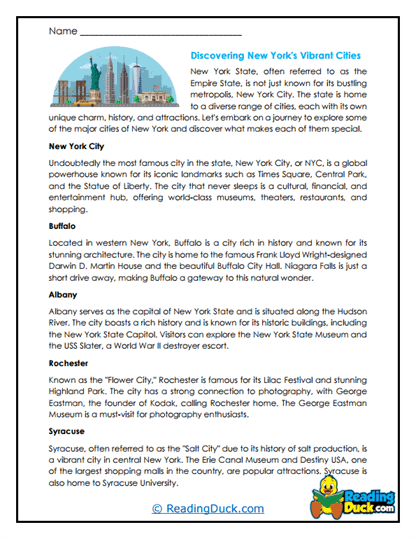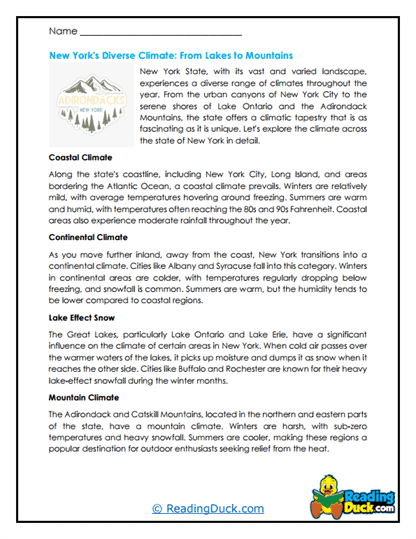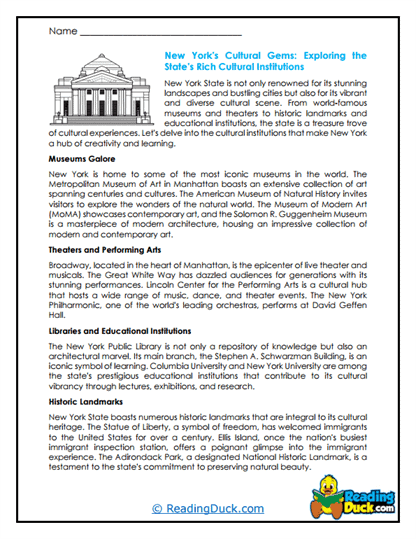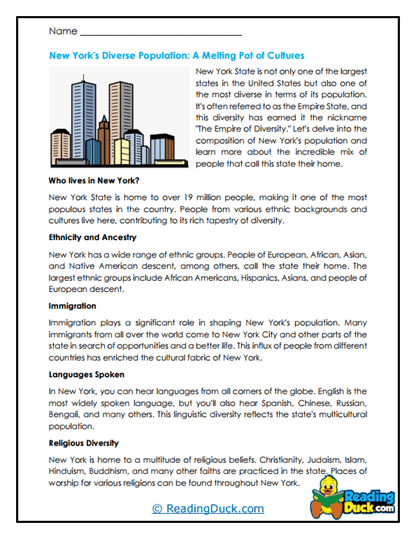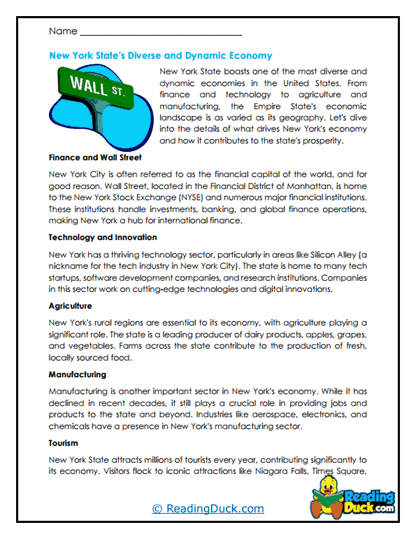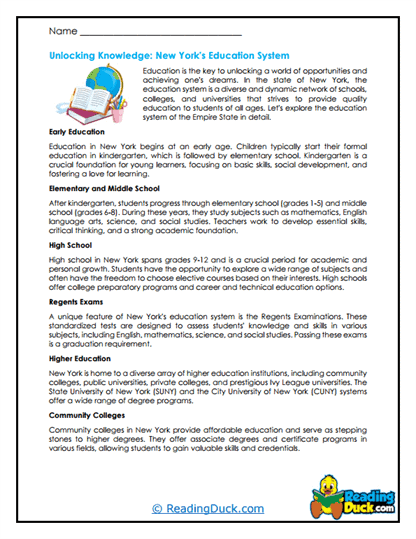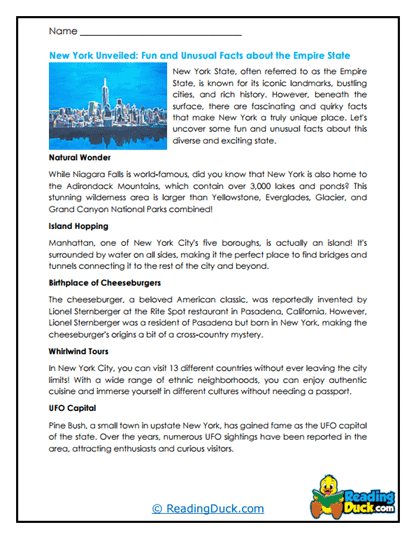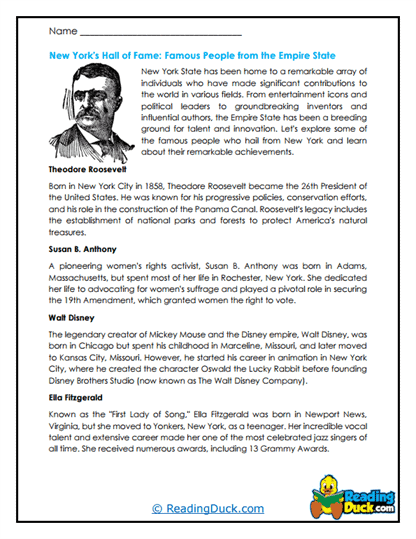New York Worksheets
About Our New York Worksheets
Our collection of New York worksheets offers students an engaging and comprehensive exploration of the Empire State’s rich history, diverse culture, and significant contributions to the development of the United States. Designed for Social Studies under U.S. History, these worksheets cover essential events, key figures, and the unique characteristics that make New York a vital part of American history. Each worksheet set includes various activities to reinforce understanding and encourage critical thinking.
Each worksheet set includes:
- Multiple Choice Questions: These questions assess students' understanding of the reading passage by offering several answer options, helping to reinforce essential facts and concepts about New York’s history, geography, and culture.
- Short Answer Questions: In this section, students are encouraged to write their own answers to questions based on the reading passage. This format allows students to express their understanding in their own words, promoting deeper comprehension of the material.
- Open-Ended Questions: These questions prompt students to provide personal input, opinions, or reflections related to the reading material. This format encourages students to connect the topic of New York to their own experiences and broader understanding of U.S. history.
An answer key is provided for every question sheet, making it easy for teachers and parents to review and assess students' work. All worksheets are available as PDF files, which can be easily viewed electronically, downloaded, and printed for use in classrooms or homeschool settings.
Discovering New York: The Empire State's Role in U.S. History
New York is one of the most historically significant states in the United States, with a rich legacy that spans from the early days of European colonization to its current status as a global economic and cultural hub. When introducing students to New York, it’s essential to explore the state’s pivotal role in the founding of the nation, its contributions to economic growth, and its cultural diversity.
Colonial Beginnings and the American Revolution
- Early Settlement and Dutch Influence:
- New Amsterdam: New York’s story begins with the Dutch, who established New Amsterdam on Manhattan Island in the early 17th century. The settlement quickly became a bustling port and a center of trade due to its strategic location at the mouth of the Hudson River. The Dutch influence can still be seen in many place names and cultural practices in the region today, such as Harlem and Brooklyn.
- English Takeover: In 1664, the English captured New Amsterdam without a fight, and it was renamed New York in honor of the Duke of York. This marked the beginning of English rule, which would continue until the American Revolution. The colony of New York grew rapidly under English control, becoming one of the most important colonies in the British Empire.
- New York in the American Revolution
- A Battleground State: New York played a critical role in the American Revolution. Due to its strategic location, the state was the site of several key battles, including the Battle of Saratoga, which is often considered the turning point of the war. Saratoga’s victory convinced France to join the war on the side of the American colonies, greatly aiding their fight for independence.
- Independence and the Founding of the Nation: After the Revolution, New York quickly became a center of political activity. New York City served as the first capital of the United States under the new Constitution, and it was here that George Washington was inaugurated as the first President of the United States in 1789. The state’s early embrace of democracy and its role in the formation of the new government have left a lasting legacy on the nation.
Industrial Growth and Immigration
- The Rise of Industry
- Economic Powerhouse: During the 19th century, New York emerged as an industrial powerhouse. The construction of the Erie Canal in 1825 was a significant factor in this growth, as it connected the Great Lakes with the Atlantic Ocean via the Hudson River. The canal made New York City the most important port in the United States, fueling its rapid growth and transforming it into the financial capital of the country.
- Manufacturing and Innovation: The state became a center for manufacturing, producing goods ranging from textiles to machinery. New York’s industries attracted workers from across the country and the world, contributing to its diverse population. The state also became a hub for innovation, with inventors like Thomas Edison making significant contributions to technology and industry.
- Immigration and Cultural Diversity
- Ellis Island: New York was the primary entry point for millions of immigrants during the late 19th and early 20th centuries. Ellis Island, located in New York Harbor, was the first stop for many immigrants seeking a new life in America. The state’s population grew rapidly as people from all over the world settled in New York, bringing with them a rich tapestry of cultures, languages, and traditions.
- Cultural Melting Pot: This influx of immigrants transformed New York into one of the most culturally diverse states in the nation. Neighborhoods in New York City, like Chinatown, Little Italy, and Harlem, became cultural enclaves, each contributing to the city’s vibrant and dynamic character. The state’s cultural diversity has had a profound impact on its arts, cuisine, and social life, making New York a microcosm of the world.
Modern New York
- Economic and Financial Center
- Wall Street and Global Finance: Today, New York is recognized as one of the world’s leading financial centers. Wall Street, located in the Financial District of Lower Manhattan, is synonymous with global finance and economic power. The New York Stock Exchange, the largest in the world, is a symbol of the state’s economic influence, driving not only the U.S. economy but also global markets.
- Business and Innovation: Beyond finance, New York continues to be a hub of business and innovation. The state is home to many Fortune 500 companies, and its economy is diversified across industries such as technology, media, fashion, and real estate. The concentration of corporate headquarters, research institutions, and creative industries in New York makes it a key player in the global economy.
- Cultural and Artistic Influence
- Arts and Entertainment: New York is also a global leader in arts and entertainment. Broadway in New York City is the epicenter of American theater, attracting millions of visitors each year. The state’s museums, such as the Metropolitan Museum of Art and the Museum of Modern Art, are among the most visited in the world, showcasing everything from classical art to contemporary works.
- Cultural Landmarks: New York’s influence extends beyond its borders through its contributions to music, literature, and popular culture. Iconic landmarks like the Statue of Liberty, Times Square, and Central Park are known worldwide, representing the spirit of freedom, innovation, and diversity that defines New York.
How New York Stands Out From Other States
New York stands out from other states for its unparalleled influence in both historical and modern contexts. One of the most distinctive aspects of New York is its role as a gateway to America for millions of immigrants. The state’s diverse population, shaped by waves of immigration over centuries, has created a rich cultural mosaic that is unique in the United States. This diversity has not only enriched the state’s cultural life but has also driven its economic and social development, making New York a leader in various fields from the arts to technology.
Another key characteristic that sets New York apart is its status as a global financial and cultural capital. New York City, in particular, is often considered the “Capital of the World” due to its significant impact on global finance, media, and the arts. The state’s economic power is reflected in its bustling financial district, influential media outlets, and thriving business environment. Simultaneously, New York’s cultural institutions, landmarks, and events continue to draw millions of visitors each year, solidifying its reputation as a center of creativity and innovation. The combination of its historical significance, economic might, and cultural influence makes New York a truly exceptional state.
Creative Ideas For These Worksheets
Teachers can use these New York worksheets creatively in their curriculum to enhance student learning:
- New York History Project - Assign students a project to create a visual timeline of New York’s history. They can include key events such as the founding of New Amsterdam, the construction of the Erie Canal, and the opening of Ellis Island. Students can use a mix of images, maps, and brief descriptions to illustrate New York’s evolution from a colonial outpost to a modern-day metropolis.
- Virtual Tour of New York Landmarks - Have students research and present a virtual tour of famous New York landmarks. This can include sites like the Statue of Liberty, the Empire State Building, and Broadway. Students can create digital presentations or interactive maps that take their classmates on a journey through New York’s most iconic locations, helping them understand the cultural and historical significance of these landmarks.
- Immigration Storytelling - Encourage students to explore the history of immigration through a creative storytelling project. They can choose a real or fictional immigrant’s journey to New York, focusing on their experiences at Ellis Island and their life in the city afterward. Students can write a diary entry, a short story, or even a script for a short play, bringing the immigrant experience to life while connecting it to New York’s role as a gateway to America.
These creative approaches not only make learning about New York more engaging but also help students develop a deeper understanding of the state’s historical, cultural, and economic significance.
